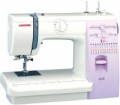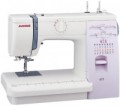Loop formation
A method of forming slotted loops supported by a machine.
—
Automatic. Fully automatic buttonhole sewing mode; the user only needs to set the length, after which the machine will independently process the edges of the future loop, without the need to switch modes manually. The most convenient and advanced option; It is the automatic method that is recommended if you plan to sew a large number of loops.
—
Semi-automatic. When forming a loop in this way, the work is done in 2 or 4 steps. For example, in the first case, the machine makes one short bartack and one long longitudinal stitch in one pass, then the mode switches and a second bartack and a second long stitch are performed; in the second case, accordingly, you have to switch between 4 stages. Such work takes more time than automatic loop formation, but such machines are cheaper.
Number of stitches
The number of stitches that a sewing machine can sew. The larger this number, the more extensive the capabilities of this model, the wider the choice the user has; however, it wouldn’t hurt to clarify the specific range of supported stitches separately.
The fewest options - mostly up to 25 - are provided in electromechanical machines, as well as specialized devices such as overlockers and carpet lockers (see “Type”). In computer-controlled devices, the number of lines can be in the dozens, and some also allow you to download additional options from the computer.
Adjustments
—
Регулировка давления лапки. Возможность изменять степень давления лапки на ткань, подстраивая ее под толщину материала: для тонких тканей (шифон, трикотаж) давление должно быть небольшим, для толстых — наоборот.
—
Регулятор натяжения нити. Приспособление, позволяющее регулировать степень натяжения верхней нити. Несогласование по натяжению между верхней и нижней нитью приводит к тому, что одна из ниток вытягивает другую и шов портится; для избежания этого явления и предусматривается данная функция. Отметим, что регулировка натяжения возможна и для нижней нити — она осуществляется через челнок (такую возможность имеют все челноки). Но для этого необходимо вынимать шпульный колпачок, а то и весь челнок целиком. Верхний же регулятор располагается прямо на корпусе машинки, и пользоваться им значительно проще.
—
Стабилизатор усилия прокола. Приспособление, которое обеспечивает стабильное усилие прокола независимо от скорости работы двигателя. Особенность механики электродвигателей заключается в том, что без специальной регулировки усилие прокола заметно снижается при росте оборотов. Данная же функция позволяет поддерживать приблизительно одинаковый уровень на всем диапазоне скоростей, что положительно сказывается на качестве работы.
—
Отключение нижнего транспортера. Возможность отключить нижний транспортер машинки. Д
...анная особенность незаменима для работ, при которых ткань нужно смещать вручную — например, вышивки по сложному контуру на машинке без вышивального блока, пришивании пуговиц и т.п.
— Ограничитель скорости. Возможность задать ограничение по скорости работы машинки. Благодаря этой функции можно не бояться «пережать» педаль — даже при сильном нажиме машинка будет работать с заданной скоростью, и не быстрее. Данная особенность бывает полезна, в частности, при работах, где требуется внимательно контролировать процесс.
— Коленный рычаг подъема лапки. Приспособление, позволяющее поднимать лапку и опускать нижний транспортер движением колена, не снимая рук с ткани. Такое приспособление бывает полезно при квилтинге и некоторых разновидностях вышивки.Power consumption
The power consumed by the machine during operation. Usually, the maximum power value is indicated in the characteristics.
Most of the electricity supplied to the machine is consumed by the engine, so this indicator primarily describes the power of the engine. The higher this power, the faster the machine can work and the better it is suitable for working with dense fabrics. However, there is no strict dependence here, much also depends on the general specialization of the unit.

